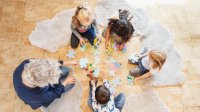Teaching Young Children to Understand Consequences
Early childhood educators can use modeling and common, everyday occurrences to demonstrate consequential thinking.
Your content has been saved!
Go to My Saved Content.Do your students have trouble connecting actions to their consequences? When asked, or confronted, with the impact of their actions, do they have difficulty tracing back what led to a situation? Sometimes, their difficulty reflects not wanting to be blamed or take responsibility. Other times, it reflects shortcomings in problem-solving skills.
As we see children and adolescents grapple with the complexity of the world around them, as well as denying responsibility for things they have done or contributed to, it’s timely to revisit proven instructional strategies to help children make connections between actions and their consequences.
Many years ago, Myrna Shure, PhD, who died in January 2023, identified “means-ends thinking” as an essential interpersonal cognitive skill—a precursor to the social and emotional learning area we now label “responsible decision-making.” She recognized that the building blocks of this skill started in preschool, and, along with George Spivack, PhD, she was a pioneer in developing activities to promote means-ends thinking in young children.
Drawing from her last book and my own work, below are examples of how to start early in helping children develop their consequential thinking.
Pre-K and Kindergarten Activities that Build Consequential Thinking
It’s useful to break down the concept of consequences into its developmental components. These are some key precursors to teach: before and after, might, and why-because. Here are some examples.
Use teacher modeling: “I am tapping my knee; I am patting my head. I tapped my knee first. I tapped my knee before I tapped my head. I am clapping my hands; I am touching my nose. I clapped my hands first. I clapped my hands before I touched my nose.”
Present two actions, and ask the class which one was before the other: Start with a simple example: “When you put on your shoes and socks, which one do you put on first? Do you put your socks on before your shoes?” Then repeat all the activities, except reverse them so that the key concepts are what is done second and after.
Look for times during the day to verbalize before and after (and first and second), such as putting out plates before lunch, putting on jackets before going outside, and cleaning up after an activity or task is over.
Explain the concept of “might” to students, which introduces the idea of possibility: It’s connected to the idea that we can’t always be absolutely sure of the consequences of actions, even if we can have a pretty good idea of what might happen. (“Might” questions usually have more than one possible answer, so “How else…?” is also a valuable prompt.)
- “How might your teacher/classmates feel if you do not help with cleaning up?”
- “How might your classmates feel if you go in front of them in line instead of waiting your turn?”
- “How might you feel if your teacher tells you that you did a wonderful job on a project?”
- “How might a classmate feel if another student hits them?”
- “How might a friend feel if you lost a toy they let you take home?”
Introduce the concept of “why-because” to students: This helps children start to make connections between two actions, from which consequential thinking can emerge. As is typical with Shure’s pedagogy of “dialoguing”—asking questions to stimulate and guide children’s thinking—it’s good to begin with teacher modeling.
Start by saying, “I am going to say something, and when I finish, you all say out loud together, ‘Why?’ I will answer with the word ‘because’ and then give a reason. Ready? Here we go!”
- “I am hungry. You all say, ‘Why?’ Because I have not had my lunch yet. Ready for another one?”
- “I like going to school. ‘Why?’ Because I like to see all of you students.”
- “I am not going to sing today. ‘Why?’ Because my throat hurts.”
- “I am tired. ‘Why?’ Because [I did not sleep well last night, something woke me up early, I just walked/ran for a long time, my dog was barking when I tried to fall asleep.]
To build students’ vocabulary around emotions, use different emotions as the stem, instead of tired: “I am… happy, sad, proud, frustrated, annoyed, confused, hopeful, excited, scared, silly, joyful.”
Sample Activities for First Grade
By first grade, children are ready to think about consequences by focusing on the prompt, “What do you think might happen if X does Y? What else might happen?” when they are reading or hearing stories. To help ensure that children pay attention to various people in the story, not only the main characters, you can add, “What might happen to W if X does Y? What might happen to Z? Is it the same or different?”
Here’s an example:
Lior is at a family party. A very big dinner was served. Now, many desserts are out on the table. Lior’s dad tells him that he can have only one dessert because he had such a big dinner. Lior is unhappy because so many of the desserts look so good.
What might happen if Lior takes an extra dessert? What else might happen? (Lior could get a stomachache, or get caught by Dad, or enjoy it and be happy.)
When reading picture books to young children, ask them some variation of “What might happen next? What else might happen?” before you turn the page. Doing this periodically will stimulate children’s curiosity, consequential thinking, and creative writing skills.
These activities, done regularly over weeks, months, and years, provide students with the building blocks of sophisticated problem-solving skills that will be invaluable to them in their teenage years and beyond.
